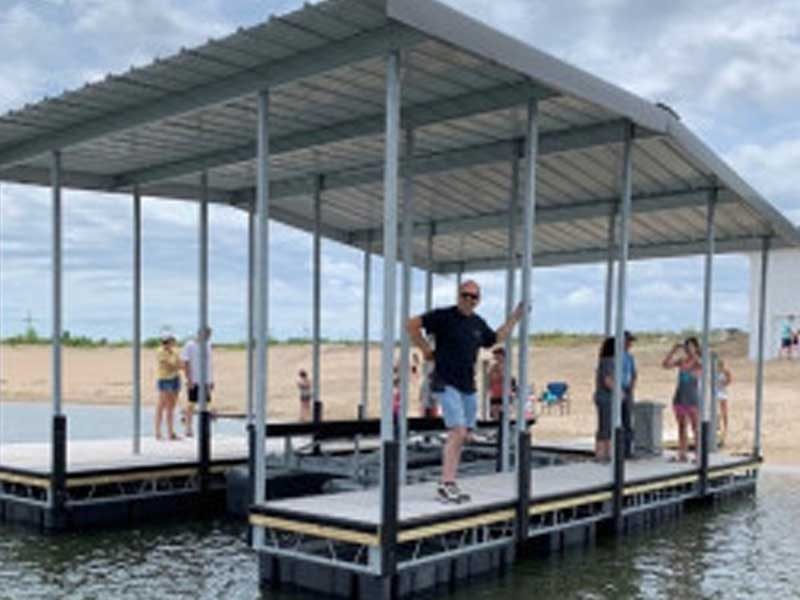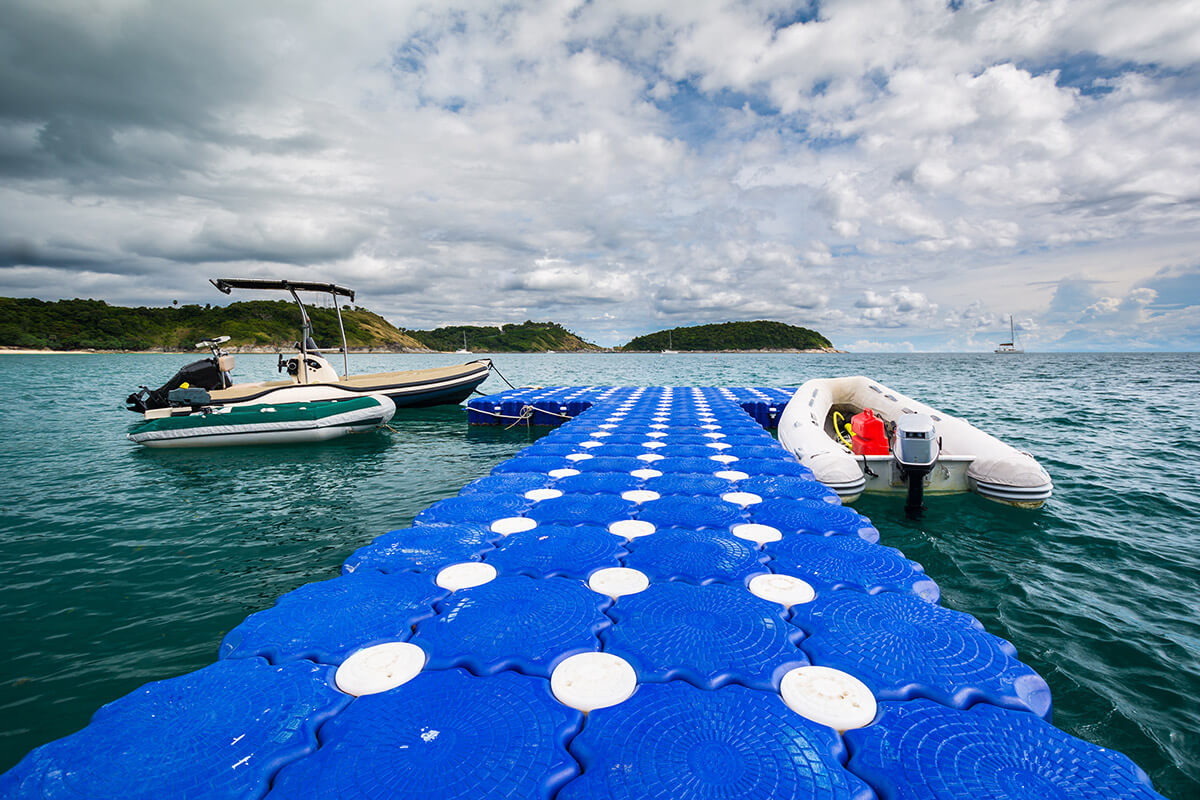Floating Docks: The Smart Option for Modern Waterfront Living and Entertainment
Floating Docks: The Smart Option for Modern Waterfront Living and Entertainment
Blog Article
Develop the Perfect Docking Service With Floating Docks
Floating docks existing a functional solution for a variety of maritime needs, adjusting perfectly to rising and fall water levels and diverse vessel kinds. Their modular nature enables fast installation and moving, yet the choice of proper materials and layout attributes is vital for ensuring both capability and visual appeal. As we explore the essential aspects that add to the efficiency of floating docks, numerous crucial aspects relating to security and maintenance will certainly arise, questioning regarding how to maximize your docking experience. The subsequent discussion will certainly brighten these vital considerations.

Advantages of Floating Docks
Floating docks deal various advantages that make them an optimal option for numerous maritime applications. Unlike fixed docks, floating docks rise and fall with the trend, making certain regular accessibility for vessels.
Additionally, floating docks are normally less complicated and quicker to install contrasted to standard fixed structures. Their modular style permits uncomplicated setting up and disassembly, promoting upkeep and relocation when essential. This versatility is specifically advantageous for short-term applications or in environments where problems may alter.
Floating docks additionally often tend to be extra ecologically friendly, as they lessen interruption to the seabed and bordering marine environments. Their buoyant nature minimizes the threat of damages to marine life, advertising a much healthier atmosphere. These docks can be tailored to accommodate different vessel sizes, making certain that they fulfill certain operational needs.
Inevitably, the combination of flexibility, ease of installment, and ecological considerations makes floating docks an extremely reliable option for a variety of maritime demands.
Picking the Right Products
Selecting the appropriate materials for floating docks is essential to make certain stability, toughness, and longevity. The selection of materials directly impacts the dock's performance in different ecological conditions, including exposure to water, sunlight, and prospective wear from marine web traffic.
Typical products made use of for floating docks consist of light weight aluminum, timber, and high-density polyethylene (HDPE) Light weight aluminum is light-weight, corrosion-resistant, and needs very little upkeep, making it a superb selection for long life. However, its initial expense can be higher compared to various other products.
Timber, while cosmetically appealing and giving a conventional look, can be susceptible to rot and insect damage if not correctly treated. For that reason, making use of pressure-treated timber or naturally durable varieties like cedar or redwood can mitigate these issues.
HDPE is a prominent selection as a result of its resistance to UV rays and chemicals, together with being eco-friendly. dock company. It is light-weight and offered in different colors, enabling customization
Ultimately, the best material selection will depend upon certain demands, consisting of budget plan, wanted aesthetics, and ecological considerations. Cautious evaluation of these variables will certainly result in a effective and resilient floating dock remedy.
Design Factors To Consider for Security
When designing floating docks, making certain stability is a fundamental element that can considerably impact their capability and safety and security. Security in floating dock style is influenced by different aspects, consisting of buoyancy, weight circulation, and the setup of elements.
Weight circulation is important; equally dispersing lots throughout the dock stops turning and enhances stability. This can be accomplished with strategic positioning of docking tools, such as fenders and cleats, along with appropriate spacing of floats. Furthermore, the dimensions of the dock should be thoughtfully planned. Larger designs can offer increased stability, particularly in rough water problems, while longer docks might need extra supports to avoid sagging.
An additional essential consideration is the ecological influence, including wave activity and wind. Integrating features such as sidewalls or skirting can aid mitigate the impacts of environmental forces, maintaining security in unfavorable problems. Eventually, a mix of thoughtful layout, material option, and understanding of environmental variables will certainly produce a drifting dock that meets both security and security requirements.
Installment Tips and Techniques

Next, secure the required licenses and follow local laws, which might determine setup techniques and environmental browse around here considerations. If called for, engage a qualified professional experienced in floating dock setups. Usage high-grade products designed for aquatic environments to enhance longevity and longevity.
When placing the dock, straighten it alongside the coastline to promote very easy access. Ensure that the anchoring system is durable, employing concrete blocks or helical supports to support the dock against wind and wave activity. It's critical to make up seasonal water degree fluctuations, consisting of prospective ice movement in cooler environments.
During the installment, confirm the dock's floatation and stability prior to completing the anchoring. Frequently inspect the setup for any indicators of wear or damage. By adhering to these pointers and methods, you can attain a protected, useful, and cosmetically pleasing floating dock setup that fulfills your requirements.
Maintenance and Care Guidelines
Keeping and caring for floating docks is crucial More Help to extending their lifespan and guaranteeing risk-free use. Regular examinations ought to be carried out to determine any kind of indications of wear, damage, or aquatic growth. Seek splits, loose fittings, or tarnished locations on the dock's surface area, as these concerns can endanger architectural honesty.
Cleansing is essential. Utilize a stress washing machine to get rid of algae, barnacles, and particles, which can accumulate gradually. For persistent development, take into consideration eco friendly cleansing representatives that won't hurt water life.
In addition, check the mooring lines and anchors frequently to ensure they are secure and totally free from deterioration. Change any type of torn or harmed lines without delay to preserve stability.
Throughout severe climate, such as storms or freezing conditions, take precautionary steps. Safeguard the dock with extra mooring lines and, if practical, remove any detachable components to prevent damages.
Verdict
Finally, the application of floating docks provides a effective and versatile docking remedy appropriate for various maritime applications. Their flexibility to fluctuating water degrees, integrated with a modular design, permits very easy personalization and relocation. Picking proper materials enhances both resilience and aesthetic charm, while careful consideration of stability ensures security and longevity. With appropriate setup and normal maintenance, floating docks can provide effective and trustworthy docking experiences for a vast array of vessels.
As we check out the crucial elements that contribute to the effectiveness of floating docks, numerous crucial elements pertaining to security and maintenance will arise, raising concerns regarding just how to maximize your docking experience. Unlike taken care of docks, floating docks rise i was reading this and fall with the trend, guaranteeing consistent ease of access for vessels.When designing floating docks, making sure security is a basic aspect that can dramatically affect their functionality and safety. Stability in floating dock layout is affected by numerous variables, consisting of buoyancy, weight circulation, and the arrangement of components. Ultimately, a combination of thoughtful layout, material choice, and understanding of environmental elements will produce a drifting dock that fulfills both stability and security requirements.
Report this page